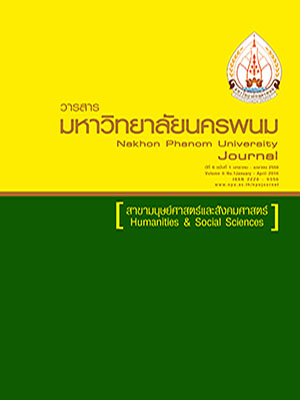ความร่วมมือของผู้มีส่วนได้เสียและแผนธุรกิจที่มีบทบาทในการขับเคลื่อนกลุ่มวิสาหกิจหนึ่งตำบล หนึ่งผลิตภัณฑ์ (OTOP) ให้มีความได้เปรียบในการแข่งขันอย่างยั่งยืน
Main Article Content
Abstract
การวิจัยนี้มีวัตถุประสงค์เพื่อ 1) ศึกษาสภาพการดำเนินงานของกลุ่มวิสาหกิจหนึ่งตำบล หนึ่งผลิตภัณฑ์ (OTOP) และ 2) ศึกษาความร่วมมือของผู้มีส่วนได้เสียและแผนธุรกิจที่มีบทบาทในการขับเคลื่อนกลุ่มวิสาหกิจหนึ่งตำบล หนึ่งผลิตภัณฑ์ (OTOP) ให้มีความได้เปรียบในการแข่งขัน ประชากร คือ ผู้ลงทะเบียนเป็นผู้ประกอบการทั้ง 3 ประเภท คือ 1) กลุ่มผู้ผลิต 2) กลุ่มผู้ประกอบการหนึ่งตำบลหนึ่งผลิตภัณฑ์ (OTOP) และ 3) กลุ่ม SMEs จังหวัดแม่ฮ่องสอน จำนวน 198 ราย เครื่องมือในการเก็บข้อมูลเป็นแบบสัมภาษณ์วิเคราะห์ข้อมูลโดยใช้สถิติพรรณนา เพื่อหาค่าร้อยละและการวิเคราะห์เนื้อหา รวบรวมข้อมูลด้วยแบบสัมภาษณ์
ผลการวิจัยพบว่า 1) สภาพการดำเนินงานของกลุ่มวิสาหกิจจังหวัดแม่ฮ่องสอน ก่อกำเนิดจากนโยบายของรัฐบาลการจัดตั้งตามความต้องการของสมาชิกในชุมชนและการจัดตั้งขึ้นมาเพื่อแก้ปัญหาทางด้านเศรษฐกิจชุมชน กลุ่มวิสาหกิจส่วนใหญ่ใช้วัตถุดิบที่มีอยู่ในชุมชนมาแปรรูปเป็นผลผลิตด้วยการประยุกต์ใช้รูปแบบวิถีชีวิต ภูมิปัญญาท้องถิ่นที่ได้สืบทอดมาจากบรรพบุรุษถ่ายทอดลงสู่ผลิตภัณฑ์ให้เกิดความโดดเด่นเป็นอัตลักษณ์เฉพาะ มีการบริหารความเสี่ยงวัตถุดิบในการผลิตและมีการดำ เนินงานตามสถานการณ์ 2) ผู้มีส่วนได้เสียมีปฏิสัมพันธ์ในลักษณะของความร่วมมือในการดำเนินงานกับกลุ่มวิสาหกิจในหลายรูปแบบ อาทิ งบประมาณ วัตถุดิบ อุปกรณ์เครื่องมือการผลิต องค์ความรู้ การฝึกอบรมตลอดจนการให้ข้อเสนอแนะที่เป็นประโยชน์ผ่านการจัดเวทีประชุมเชิงปฏิบัติการแบบมีส่วนร่วม ภายใต้ความต้องการและการพัฒนากลุ่มวิสาหกิจด้วยการจัดทำแผนธุรกิจ เพราะเป็นการบ่งบอกถึงบทสรุปผู้บริหาร การวิเคราะห์ข้อดี ข้อเสีย โอกาสและอุปสรรคของวิสาหกิจที่ครอบคลุมถึงกลุ่มผู้มีส่วนได้เสีย กำหนดกลยุทธ์ธุรกิจ ดำเนินกลยุทธ์และประเมินกลยุทธ์รวมถึงการวางแผนความเสี่ยงเพื่อให้สอดคล้องกับสภาพแวดล้อมที่ส่งผลให้กลุ่มวิสาหกิจมีความได้เปรียบในการแข่งขันอย่างยั่งยืน โดยวัดจากกลุ่มวิสาหกิจที่มีการดำเนินงานอย่างต่อเนื่อง ยอดขายที่เพิ่มขึ้น จำนวนลูกค้าเพิ่มขึ้น เน้นการสร้างความแตกต่างและความประณีตของสินค้าหรือบริการที่ทำห้ลูกค้าเกิดความพึงพอใจและตอบสนองความต้องการของลูกค้า
The purposes of this study were: 1) to investigate the operating condition of OTOP (one tambon – one product) enterprises group, and 2) to examine the collaboration of stakeholders and the business plan that have a role in driving the OTOP enterprises group to a sustainable competitive advantage. The population was registrants to be entrepreneurs of three types: 1) producers, 2) OTOP entrepreneurs, and 3) SMEs group in Mae Hong Son province totaling 198 people. The instrument for collecting data was an interview guide. Data analysis was conducted through descriptive statistics of percentage. Content analysis was also employed for the data collected by interview.
Findings of the study were as follows: 1) the operating condition of Mae Hong Son enterprises group was established from the government policy. The establishment of the group followed the needs of community members to rely on it for solving the community’s economic problems. Most of enterprises used raw materials available in the community to process into products by applying the life style and local wisdom which were passed down from ancestors to create a distinguished identity. There was a risk management of raw materials in production and the operation was run according to the situation. 2) The stakeholders interacted with the enterprises group in the various forms of manner of collaboration such as budget, raw materials, production equipment and tools, body of knowledge, training as well as the useful feedback providing by holding a participatory workshop to meet their need. And then the enterprises group was developed through business plan making which indicated a summary of the executives. The SWOT analysis of the enterprises which covered all stakeholders could help foresee these determinations: to make a business strategy, to implement it, and to assess it. In addition, a risk management plan was made in accordance with the environment that resulted in the enterprises group’s sustainable competitive advantage. All the measures can be seen from the enterprises that are operating continuously with their increase of sales and customers by putting emphasis on making a difference with the neatness of products or by giving the service that makes the customers satisfied or by meeting their needs.


